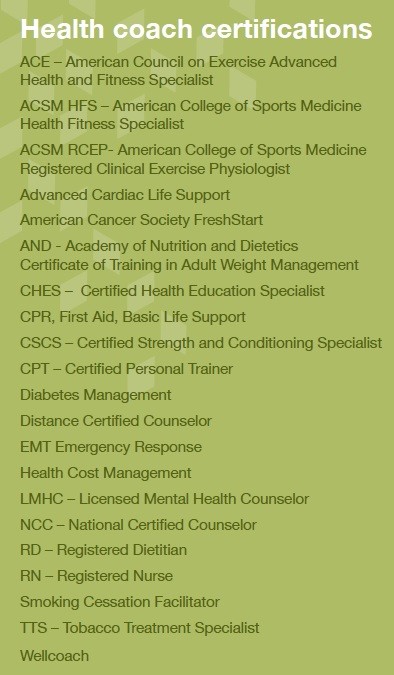 Not all health coaching programs are created equal. Here are a few things to consider as you compare programs:
Not all health coaching programs are created equal. Here are a few things to consider as you compare programs:
Coach personality attributes and motivational training
Of course you want health coaches who are experienced and trained in health sciences and health promotion. But health knowledge is only part of the picture. To help someone change an ingrained behavior such as smoking takes more than a health degree. Coaches should have personality attributes that help participants feel respected, empowered, and personally responsible for their goals and actions. Training in approaches such as motivational interviewing expands on those personality traits. These health coaches help individuals place value on health, address ambivalence to change, set goals, own actions, build supportive environments and networks, overcome obstacles, and celebrate successes.
Clinical oversight
A health coaching program needs clinical oversight to make sure that coaches follow protocols defined by evidence-based guidelines, to review clinical solutions, and to ensure intervention credentialing. Look for a chief medical officer (CMO) and a clinical advisory board with recognized experts from a variety of backgrounds  such as medicine, behavior change science, obesity, tobacco cessation, and health analytics.
such as medicine, behavior change science, obesity, tobacco cessation, and health analytics.
How participants are identified as coaching-eligible
Neither behavior nor health status is determined by one factor alone. A combination of the number of risks, acuity of risks, and the impact that each risk has on overall health and healthcare costs more accurately stratifies individuals into the right intensity program. Participants may also be identified for coaching based on their stage of being ready to make a change in their health behaviors. But don’t overlook individuals who report being unready to change; most individuals are willing to work on at least one risk factor and coaching may help people become ready to change.
Whole-person health coaching
A whole-person approach to health coaching takes all of an individual’s health risks and conditions into consideration, as opposed to a siloed approach that limits health coaching efforts to one health risk. An employee who is struggling with weight, stress, and a sedentary lifestyle needs one comprehensive coaching program, not three siloed programs. A participant-centered approach uses a variety of techniques to help participants find their own motivation to make lasting changes for improved health.
Coaching is part of a broader health management program
Effective health coaching is incorporated within a broader population health management initiative. Make sure that your coaching program leverages robust online and offline capabilities that allow coaches to access and view participants’ progress.
Additional services to look for
- Health management consulting services to help you design and optimize your health management and wellness programs.
- Strategic engagement services that include communications and incentives support to encourage the highest possible participation rates.
- Onsite health promotion services such as health fair and biometric screening coordination to help launch your program.
- Outcomes reporting and analytics support to demonstrate your program’s efficacy to senior management and identify specific opportunities to optimize your programs going forward.
To learn more about best practices in health coaching, download our eBook “The Essential Guide to Health Coaching.”

